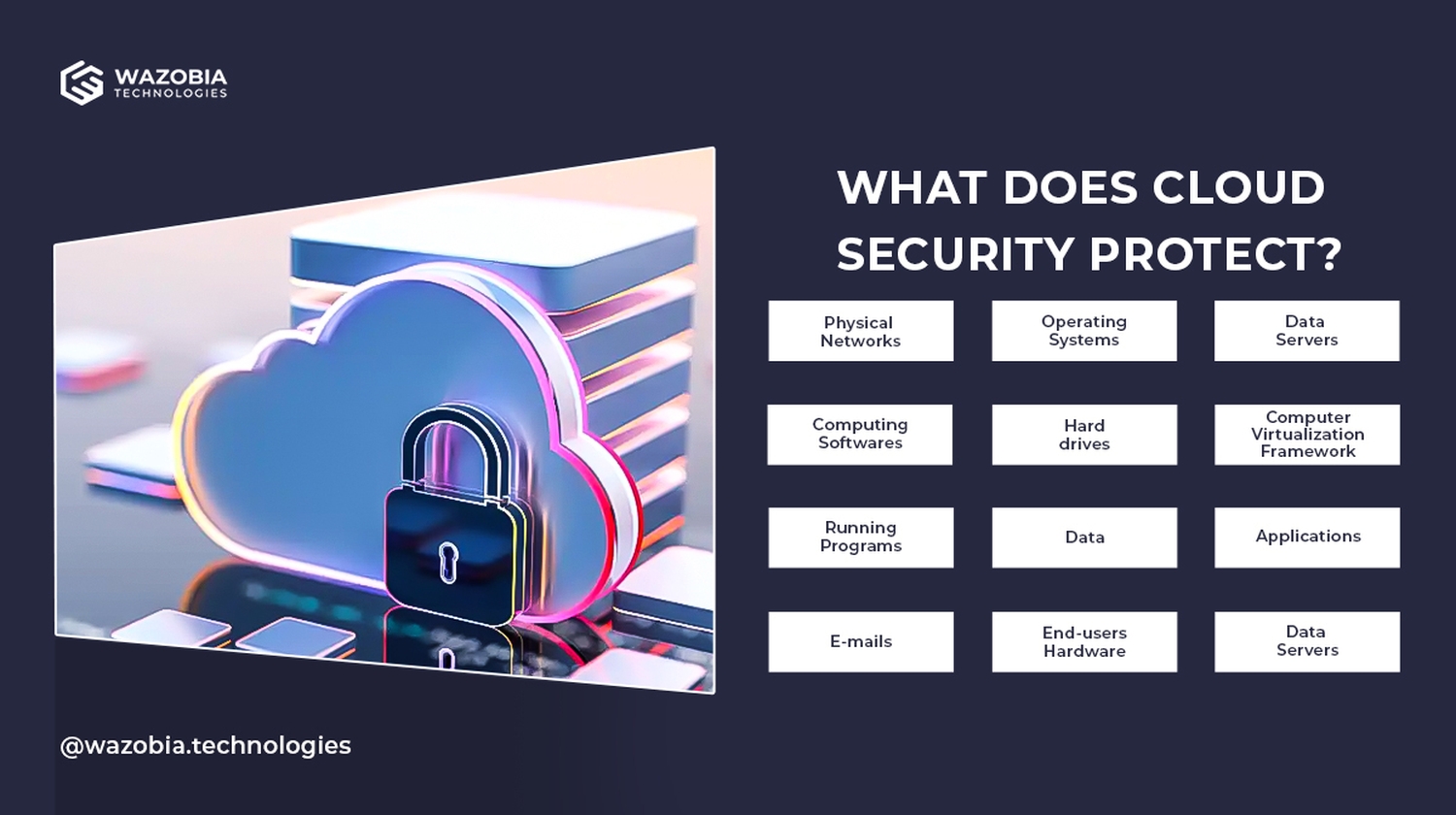Blog/Cloud Computing
How to Protect Your Cloud: Best Practices for Cloud Security

If you're here, it's probably because you know all about the cloud and are concerned about protecting your information. However, for the benefit of the doubt, the cloud refers to a vast network of remote servers located around the world. These servers are housed in data centers and work together to provide various services to users over the internet. It's like a giant digital storage space and processing center that you can access from anywhere, anytime, with an internet connection.
As we all increasingly rely on cloud computing to store, manage, and process our data, reaping benefits such as scalability, flexibility, and cost-effectiveness, we've also become exposed to unique security challenges. From data breaches to unauthorized access, protecting your cloud infrastructure is paramount to safeguarding sensitive information and maintaining the trust of your customers. In this comprehensive guide, we'll explore the best practices for ensuring the security of your cloud environment.
- What is cloud security?
- How do you protect your cloud?
- Benefits of protecting your cloud
- Best cloud security companies
- Conclusion
What is Cloud security?
Cloud security refers to the policies, control mechanisms, and technologies designed to protect data associated with cloud computing structures from internal and external threats to a business's security. It functions through cloud security frameworks, which are structured guidelines designed to help organisations establish comprehensive and adequate security measures within their cloud computing environments. These frameworks provide a set of best practices, controls, and recommendations to help ensure the security of data and resources in the cloud.
- Data security
- Identity and access management (IAM)
- Governance (policies on threat prevention, detection, and mitigation)
- Data retention (DR) and business continuity (BC) planning
- Legal compliance
How Do You Protect Your Cloud?
Protecting your cloud consists of an extensive list of guidelines. We've however, compiled a list of best practices that vastly improve your cloud security. Some of them include:
1. Understand Your Responsibilities
One of the first steps in protecting your cloud is understanding the shared responsibility model. Cloud service providers (CSPs) like Amazon Web Services (AWS), Microsoft Azure, and Google Cloud Platform (GCP) offer a range of security features, but ultimately, the responsibility for securing your data and applications rests with you, the customer. Familiarize yourself with the division of responsibilities outlined by your CSP and take proactive measures to fulfill your obligations.
2. Implement Strong Access Controls
Effective access control is essential for preventing unauthorized access to your cloud resources. Use strong authentication methods, such as multi-factor authentication (MFA), to verify users' identities and enforce the principle of least privilege, granting users access only to the resources they need to perform their roles. Regularly review and update access permissions to ensure they align with your organization's evolving requirements.
3. Encrypt Data at Rest and in Transit
Encrypting sensitive data is crucial for protecting it from unauthorized access, both at rest and in transit. Utilize encryption mechanisms provided by your CSP, such as AWS Key Management Service (KMS) or Azure Key Vault, to encrypt data stored in your cloud environment. Additionally, implement secure communication protocols such as Transport Layer Security (TLS) to encrypt data transmitted between your users and cloud services.
4. Monitor and Audit Activity
Continuous monitoring and auditing of your cloud environment are essential for detecting and responding to security incidents in a timely manner. Leverage cloud-native monitoring tools, such as AWS CloudTrail or Azure Monitor, to track user activity, resource changes, and potential security threats. Set up alerts for suspicious behavior or unauthorized access attempts and conduct regular audits to ensure compliance with security policies and regulations.
5. Secure Your Applications
Securing your cloud-based applications is critical for protecting sensitive data and maintaining the integrity of your infrastructure. Follow best practices for application security, such as implementing secure coding practices, regularly patching and updating software components, and conducting vulnerability assessments and penetration testing. Utilize web application firewalls (WAFs) and intrusion detection systems (IDS) to monitor and mitigate threats targeting your applications.
6. Backup and Disaster Recovery
Implement robust backup and disaster recovery strategies to protect your data against accidental deletion, hardware failures, or malicious attacks. Regularly back up your critical data and ensure backups are stored securely in a separate location, preferably in a different geographic region. Test your disaster recovery plan regularly to ensure it is effective in restoring operations in the event of a disruption or outage.
7. Educate Your Team
Security is everyone's responsibility, so it's essential to educate your team about the importance of cloud security and best practices for protecting sensitive information. Provide training and awareness programs to help employees recognize common security threats, such as phishing attacks or social engineering scams, and teach them how to respond appropriately. Foster a culture of security awareness and encourage employees to report any suspicious activity promptly.
8. Stay Up-to-Date with Security Trends
The cybersecurity landscape is constantly evolving, with new threats emerging regularly. Stay informed about the latest security trends, vulnerabilities, and best practices by following reputable security blogs, attending industry conferences, and participating in security forums and communities. Regularly review and update your security policies and procedures to address emerging threats and ensure your cloud environment remains secure.
9. Engage with Third-Party Security Experts
Consider engaging with third-party security experts or consultants to assess the security posture of your cloud environment and provide recommendations for improvement. Independent security assessments, penetration testing, and security audits can help identify vulnerabilities and weaknesses in your infrastructure before they are exploited by attackers. Work with experienced professionals who have expertise in cloud security to ensure comprehensive coverage and protection.
Benefits of protecting your cloud
Ironclad Data Encryption
Cloud providers often employ robust encryption methods to protect your data while it's being transferred (in transit) and stored (at rest). This ensures that even if unauthorized individuals manage to intercept your data, they won't be able to access its contents. This significantly reduces the risk of data breaches and leaks, which can have severe legal and financial repercussions.
Effortless Security Updates
Unlike traditional on-premise systems, cloud platforms are constantly evolving. Cloud providers regularly update their security measures to address emerging threats and vulnerabilities. Additionally, they often offer automatic software updates, eliminating the need for manual patching and updates, which can be a time-consuming and resource-intensive task for many organizations.
Scalable Security Solutions
Cloud security solutions are inherently scalable, meaning they can effortlessly adapt to your organization's evolving needs. Whether you're a small startup or a large enterprise, cloud security can grow alongside you, ensuring consistent protection regardless of your data volume or user base. This eliminates the need for constant infrastructure upgrades and investments, allowing you to focus on your core business activities.
Granular Access Controls
Cloud security empowers you to implement fine-grained access controls. This means you can meticulously define who can access specific data and resources within your cloud environment. This granular control ensures that only authorized individuals have access to sensitive information, minimizing the risk of unauthorized access and data misuse.
Proactive Threat Detection and Response
Cloud security solutions often come equipped with centralized monitoring and advanced threat detection tools. These tools continuously scan your cloud environment for suspicious activity and potential security threats. In the event of an incident, cloud security can facilitate swift and effective response measures, minimizing damage and downtime. Additionally, many cloud providers offer disaster recovery options, ensuring business continuity even in the face of unforeseen circumstances like data loss or breaches.
By leveraging these advantages, cloud security empowers businesses and organizations to operate with greater confidence and peace of mind in the digital age. It allows them to focus on core competencies and innovation while ensuring the utmost protection for their valuable data and resources.
Best Cloud Security Companies
Trend Micro
Known for its cost-effective services, Trend Micro offers an integrated and automated approach to protect data, users, and applications in both on-premises and public cloud environments. Their advanced security capabilities include cloud workload protection, network security, file storage protection, application security, and open-source security1.
Qualys
A leader in regulatory compliance adherence, Qualys provides solutions for cloud workload protection, container security, and more. They focus on monitoring and maintaining compliance with standards like ISO 27001, SOC 2, GDPR, HIPAA, and PCI-DSS1.
Palo Alto Networks
Palo Alto excels in unified platform management. Their services cover cloud-native app protection, CASB (Cloud Access Security Broker), CIEM (Cloud Infrastructure Entitlement Management), and more. They comply with ISO 27001, GDPR, PCI-DSS, FedRAMP, and NIST standards1.
Zscaler
Zscaler is a great choice for advanced threat protection. Their offerings include DLP (Data Loss Prevention), CASB, secure internet access, posture control, and more. While specific cyber insurance coverage information isn’t available, they adhere to ISO 27001, SOC 2, GDPR, HIPAA, PCI-DSS, and FedRAMP1.
Lacework
Focused on cloud-native app protection, Lacework provides services for CWPP (Cloud Workload Protection Platform) and CIEM. They comply with ISO 27001, SOC 2, NIST, and GDPR standards1.
Tenable
Tenable specializes in secure cybersecurity insurance. Their services cover CSPM (Cloud Security Posture Management), CIEM, and vulnerability management. They comply with GDPR, HIPAA, PCI-DSS, and FedRAMP
Conclusion
Protecting your cloud environment requires a multi-faceted approach that encompasses technical controls, operational practices, and user awareness. By following the best practices outlined in this guide and staying vigilant against emerging threats, you can effectively safeguard your data, applications, and infrastructure in the cloud.
Remember that security is an ongoing process, and regularly review and update your security measures to adapt to evolving threats and maintain the integrity of your cloud environment.
Related post
Recent Posts
Need help with a project?
© Wazobia Technologies 2025
Powered by:
